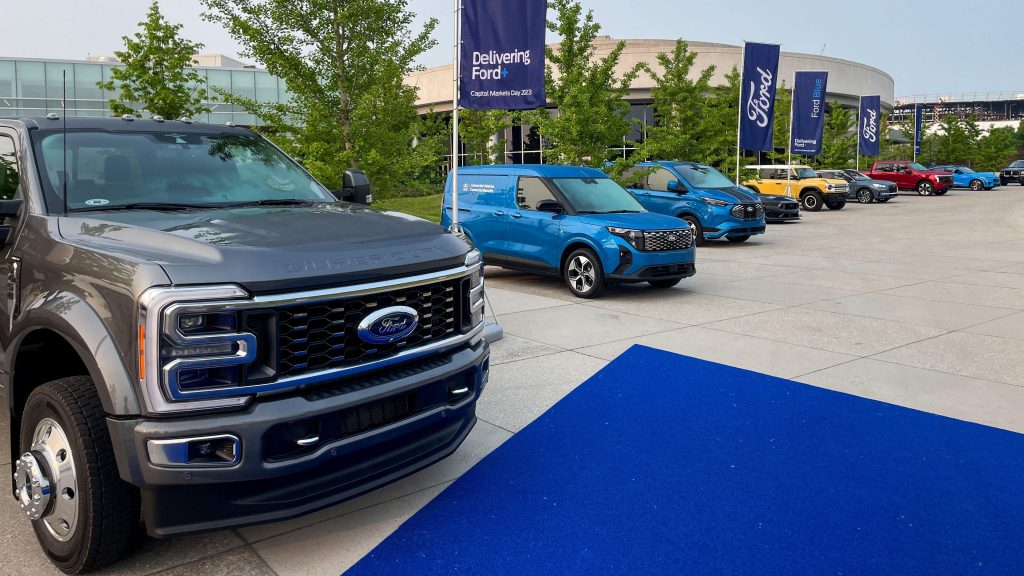Ford Has Big Goals For Software Sales To Small Business Truck Fleets

HomeTown Services, a heating and cooling repair company in Tulsa, Oklahoma, is getting ready to install driver monitoring cameras in some of its trucks, and already uses streamed data to remind drivers not to sit too long in idle vehicles, wasting gasoline.
“People will sit in a vehicle for an hour or two,” said Del Underwood, vice president for purchasing and fleets for the company. Now, technicians get a text message instructing them to either turn off their trucks or move to the next assignment.
That may annoy some employees, but it is good news for Ford Motor Co’s commercial vehicle unit, Ford Pro, which has placed a big bet on software-related services. Ford Pro hopes selling connected-vehicle services such as driver monitoring systems to small and medium sized fleet operators will help generate as much as $1.8 billion in annual profit within two years.
Ford CEO Jim Farley has urged investors to think of Ford Pro’s bundle of software and vehicle sales, not Tesla, as the “future of the automotive industry.”
Companies including Geotab and units of Verizon dominate the market for telematics services provided to large vehicle fleets, said Mike Ramsey, vice president at technology consultancy Gartner.
But Ford “can get all the guys buying Ford Transits for their plumbing business,” Ramsey said.
Small and medium-sized business fleets in North America and Europe constitute a large enough market that Farley has told investors Ford Pro could earn 20% of its pre-tax profit from selling software and services within two years.
Farley has forecast Ford Pro pre-tax profits at $8 billion to $9 billion this year. He has promised investors Pro can earn fatter margins than its consumer businesses, partly due to services and maintenance business driven by telematics connections to vehicles and data.
In 2023, Ford Pro had 500,000 paid subscriptions for software services. “It’s up 46% and the margins are over 50%,” Farley told analysts in January. He said 12% of vehicles Ford Pro sells have software subscriptions attached and he wants to triple that.
Ford Pro Chief Ted Cannis told investors last May that software subscriptions could bring in $2,000 a vehicle in revenue per year, and by adding on services such as insurance, Ford could boost that revenue per vehicle to $4,000 to $5,000.
Ford uses telematics connections to prompt commercial vehicle owners to get parts replaced before they break. Boosting the rate of service subscriptions by one percentage point can “add about $30 million of incremental EBIT to the business,” Ford Pro Chief Financial Officer Navin Kumar said last month.
Ford is also selling data from its vehicles to large fleets that subscribe to rival telematics services.
FORD’S FERRARI
While Farley sees big dollars, investors so far have not boosted Ford’s share valuation to anywhere near Tesla’s level. The Silicon Valley electric vehicle company is worth more than 10 times Ford’s market capitalization.
Morgan Stanley analyst Adam Jonas has called Ford Pro “Ford’s ‘Ferrari.'” But he also asked “How long can Ford Pro fund losses in the vertically integrated EV strategy?”
In 2023, Ford Pro earned $7.2 billion in pre-tax profits and had a 12.4% pre-tax profit margin. By comparison, Ford’s overall pre-tax profit margin was just 5.9%, reflecting the cost of United Auto Workers strikes at key U.S. factories and a $4.7 billion pre-tax loss on electric-vehicle operations.
Ford Pro’s above-average profit margins have prompted rivals to counter.
Stellantis last year grouped its commercial vehicle operations under a new name: Stellantis Pro One. Beyond emulating Ford’s use of the word “Pro,” Stellantis said it aims to generate 5 billion euros annually from sales of connected services.
General Motors last year reorganized its North American commercial vehicle business to sharpen competition with Ford Pro.
Another challenge for Ford Pro will be to make paid subscribers out of customers who currently get software and telematics services for free.
Fize Electrique, an electrical contractor in Quebec, is using Ford Pro software during a one-year free trial to monitor 12 Ford EVs it purchased for battery charge levels. That is crucial because EV batteries lose driving range faster in Quebec’s cold winter weather.
“When we got the first E-Transits, I was watching the numbers all the time,” said Alain Fiset, who oversees the company’s fleet. Data pulled from the vehicles “helped us understand what’s the state of the battery.”
That in turn convinced Fize to accelerate the move to an all-electric fleet, taking advantage of Quebec’s relatively stable power rates.
Ford Pro is experimenting with new ideas for software services, and not all the projects work out, Dave Prusinski, chief revenue officer for Ford Pro’s software operations, said in an interview.
In 2021, Ford and business software company Salesforce announced plans to develop a subscription software service called VIIZR that would automate work orders for contractors. But that project has been wound down, Prusinski said.
“Realistically it was not our core,” he said. “There were some great solutions on the market. We were seeing traction, we couldn’t catch up fast enough.”
(Reporting By Joe White, editing by Ben Klayman and David Gregorio)




